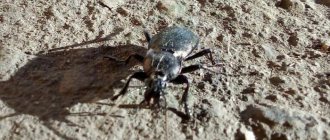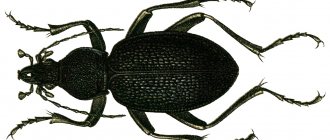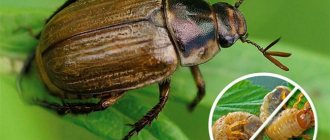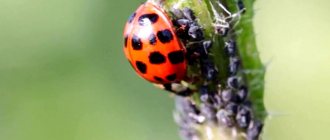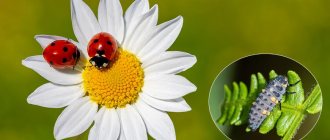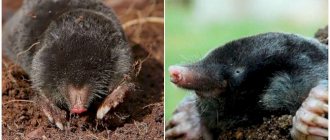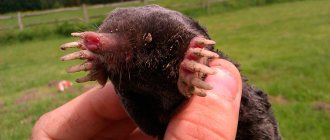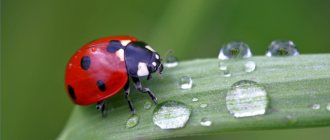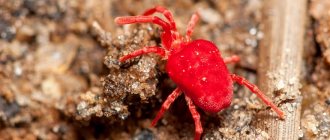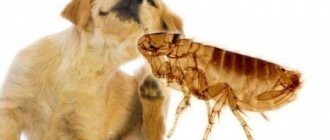The Crimean ground beetle is one of the largest and most beautiful predatory beetles living in the vast expanses of the Crimean peninsula. This species belongs to the ground beetle family, the order Coleoptera. The beetles are included in the Red Book due to a sharp decrease in their numbers. This is facilitated not only by the lack of precipitation, which affects the food supply of predators, but also by the reduction of virgin territories, as well as the use of pesticides and the catching of unique individuals by collectors.
Keeping at home
The insectarium must be decorated in such a way that it completely resembles a forest clearing.
Turf soil along with grass, fallen leaves, moss and sand are placed at its bottom. Various stones and shards are also placed here, which will serve as shelter for the insect. Earthworms, slugs, cockroaches are suitable as food - this is what the Crimean ground beetle feeds in natural conditions. The maintenance of larvae is not much different from the conditions for adult beetles. The main thing is that they are kept separate from them. Twice a day (morning and evening), the grass should be lightly sprayed with water to maintain the required humidity.
Swimming beetle
This is an underwater predatory coleopteran that inhabits standing deep waters with abundant vegetation. In this environment, such carnivorous creatures always have a huge supply of food, that is, a variety of living creatures. Sometimes these creatures even choose small fish and newts as their victims.
By the way, having caught them, they are able to absorb them with amazing gluttony and speed. The larvae of such beetles are also very dangerous. They launch predatory mandibles into their victims, through the channels of which digestive juice passes, and back they suck in food that is already suitable for consumption in a digested state.
Numerous species of such beetles are grouped into the diving beetles family. One of its representatives has a flat, oval, dark green body on top, bordered by yellowness at the edges, which is why the species is called “bordered swimmer.” Its hind pair of legs is covered with hairs and has a paddle-like shape.
And the body itself is similar in structure to a submarine: it is rounded, smooth and flat. Thus, nature itself made sure that these creatures, no more than 5 cm long, felt at ease in the water element, moving there energetically and agilely. But such insects are also capable of moving on land. They usually reach areas near bodies of water by air, using their wings.
Reproduction
Most insects do not live longer than a year, but the Caucasian ground beetle is an exception. The lifespan of the species reaches up to 3 years, and under good conditions it can live up to 5 years. The Caucasian ground beetle has all stages of complete transformation: egg, larva, pupa and adult. The breeding season for these individuals begins in the spring, usually from April to May. The female lays 70 eggs in just one clutch.
Caucasian beetles are very picky in choosing the place where their larvae will develop. Choose damp and warm soil into which sunlight does not penetrate. Before laying her eggs, the female digs a small hole at least three centimeters deep. The period of metamorphosis of an egg into a larva takes two or more weeks. The formed larva is up to 2 centimeters in length. For the first few hours, the larvae of the Caucasian ground beetle are white in color, but then they begin to darken until they turn black. The larvae spend time in this role until the end of the summer season, and live and feed in the same way as their adult companions.
In order to obtain food, the Caucasian ground beetle larva has a well-developed jaw apparatus, which is present in adult individuals. The transformation into a cocoon occurs at the beginning of autumn, and it becomes a fully formed Caucasian beetle only with the arrival of spring.
Wood boring beetles
Another type of vegetarian beetle has turned into a terrible enemy of humanity. And it is not surprising, because they are not only destroyers of garden trees, but also terrible destroyers of wooden buildings and furniture, because they feed on wood.
Let's list the most famous types of wood-boring beetles , and also tell you in more detail about their unseemly activities. Here they are:
1. The house longhorned beetle, a representative of the longhorned beetle family, which also received the nickname of the house woodcutter, is a so-called technical pest because it rarely harms living trees, but only those that have been cut down and cut down. It is found only in dry, dead wood, mostly coniferous trees. Adult beetles are usually about 7 mm or more in size. They have an oblong body, rounded at the back, most often dark brown in color, covered below with erect, light hairs.
In the course of their life, such wood lovers lay winding labyrinths in it, where they leave their elongated, whitish eggs. Those wooden objects where such beetles settle, after some time become covered with a coating similar to flour, then become unusable and are destroyed;
2. Hooded beetles are also a whole family of tree pests. Its representatives are bugs, about one and a half centimeters in size. In Europe, the most common variety has a black front and red back.
In Arabia and Africa, another one became especially famous: brown in color with protruding pectoral processes, similar to horns. The entire family includes about 7 hundred species. Most of them live in the tropics;
3. Representatives of the family of drillers are famous for the width of the moves they make, for which they received their nickname. The most attractive wood species for them are walnut and oak. Interestingly, such beetles feed not on the wood itself, but on fungal mold, for the growth of which favorable conditions are created due to the penetration of moisture into the damage. Most often, beetles are reddish in color. They have very elongated, thin bodies, averaging about 1 cm in length;
4. Grinders are another family of wood pests. For the most part, these are reddish-brown bugs, no more than a centimeter in size, with a comb-shaped antennae. They feed on both dead and living wood, and are sometimes found in food and medicine. In the process of life, they emit very strange sounds, similar to the ticking of a clock, by which one can recognize the settlement of unpleasant guests;
5. Bark beetles are a subfamily of the weevil family. There species of bark beetles around the world, and more than a hundred in Europe. These are small dark brown creatures, the largest of them reach 8 mm in size, but there are also very small ones, only a millimeter in size.
They are capable of infecting living trees, even the stems of some grasses, penetrating deeply into their tissues. If they start in dead wood, then not in dry wood, but in wet wood. Some varieties spread fungal mold spores, which subsequently serve as food for their larvae.
Such organisms live in the tropics, as well as in areas with temperate climates, including Europe. Often hordes of beetles become a real natural disaster, destroying literally everything wooden in their path.
Appearance
The graceful ground beetle has a body on which the head, chest and abdomen are oval in shape. The length of the beetle sometimes reaches 52 mm. This insect cannot fly - its wings are undeveloped, but its long legs allow it to run quite quickly. The front legs are adapted for cleaning the antennae due to the presence of a notch with dense hairs.
The Crimean ground beetle (photos of its representatives can be seen in the article) has several forms, differing in color, which can be blue, purple, green or black. The light on the surface of the coarse, wrinkled coatings is refracted, resulting in the illusion of the insect changing color. Experts call this feature optical coloring. The lower part of the ground beetle's body is black, with a shiny metallic tint.
Sexual demorphism is weakly expressed. Females are slightly larger, and males can be distinguished by their longer antennae and extended forelegs. The lifespan of these insects is 10-11 years.
Hercules beetle
This resident of the New World, in particular the tropical forests of the Caribbean islands, as well as the southern and central part of the American continent, is famous for its remarkable parameters. It was thanks to them that he became the record holder for size among the beetles of the planet. Its maximum size can be up to 17 cm. Just think, only its gigantic wings can boast a span of 22 cm.
In addition, the appearance of the Hercules beetle is very unusual. The front part of the body is black and shiny. The head of males is decorated with a huge, forward-pointing upper horn, equipped with teeth.
There is also a second, smaller one, located lower and extending from the pronotum. The body of the beetle is slightly hairy, but such vegetation is quite sparse and red in color. The elytra come in different shades: olive, yellow, brown, and sometimes gray-blue.
The beetle got its name not only for its outstanding size, it has tremendous strength. But giants are quite harmless to others and humans. For the most part, they feed on dry tree bark, fallen leaves, slightly rotten fruits and other organic matter that has undergone changes, thereby benefiting the ecosystem.
Beetles need horns for fights with their own kind, because in relation to other Hercules they are very militant. They fight for spheres of influence, for a place in the social hierarchy, but most of all because of females. And in a fight for the latter, they are capable of severely injuring and even killing their opponents.
Features of behavior
The Crimean ground beetle is a predator that most often leads a nocturnal lifestyle. Occasionally, it may appear during the day in search of food. Muscular long legs help hunt prey. With their help, the beetle also escapes from enemies. In one night, the insect can cover a distance of up to 2 km. At the same time, he has to maneuver to get to the most vulnerable spot of the victim. It is very difficult to catch a ground beetle - it is so evasive and fast.
When it is not possible to escape from the enemy with the help of its legs, it releases from its abdomen a stream of caustic brown liquid with an unpleasant, pungent odor. The formic acid contained in its composition causes severe pain and lacrimation if it gets into the eyes.
May beetles
These coleopterous insects are among the fairly large ones, reaching a length of at least 2 cm, in some cases more than 3 cm. They get their name from the fact that they appear and begin to fly actively at that period of the year when spring nature blooms in lush colors, warmed the gentle light of the May sun.
The beetles have an oval-shaped, red-brown or black-colored body strewn with hairs, in some cases slightly green, sometimes with yellowish elytra.
Such insects, if their numbers are large, can cause considerable harm to cultivated and wild plants by eating their young shoots. Their larvae are very voracious and feed on the roots of trees and shrubs. species of May beetles. And all of them are united in a genus with the same name.
Enemies
Caucasian ground beetles are carnivorous predators; many species of ants and birds do not mind feasting on eggs, larvae and the beetles themselves. Many badgers and hedgehogs are a potential threat to this species. Caucasian beetles can become a snack for bears and wild pigs. However, the greatest pests for the development of the population are ants, which climb into the shelter of ground beetles and eat their larvae and eggs. Ants do not risk attacking adult individuals, since due to their small size they themselves will become a victim of the insect.
It is surprising that the Caucasian ground beetle feeds on many insect pests, so this representative has only a positive effect on the development of agricultural crops. However, many people do not realize this, so when they see this representative they try to immediately destroy it.
The population of the Caucasian ground beetle is under threat, and in order to prevent an even greater decline in the species, this species was included in the Red Book of Russia and Georgia.
Colorado beetle
It just so happens that carnivorous types of beetles are for the most part considered beneficial because they eat small pests from among their insect relatives. And the more insatiable the predator, the more benefit it brings. Of course, we judge from the point of view of us, people.
But humanity has disliked vegetarian beetles, for example, members of the leaf beetle family, especially a representative of one of its species - the Colorado potato beetle . The fact is that adult individuals of these insects, along with the larvae, eat the leaves of eggplants, tomatoes, peppers with insatiable gluttony, but are especially fond of potato beds.
These terrible pests, no more than a centimeter in size, have turned into cruel invaders of our territories quite recently. Apparently, they were brought to Russia by chance. These foreigners come from the New World, more precisely from Mexico, where they initially ate tobacco and wild nightshade leaves.
Later, having adapted to feast on the potato plantings of the colonists, they gradually began to spread north to the United States, in particular they really liked it in Colorado. That's why beetles are called that way. The head and chest of such insects are orange with dark markings. The body is shiny, elongated, oval.
The elytra are decorated with black longitudinal stripes. Having recognized this terrible beetle by its signs, gardeners should immediately take action and vigorously fight the terrible aggressor. After all, Colorado potato beetles reproduce quickly.
And they are so voracious that they almost completely eat potato bushes, and not just the leaves. And having destroyed everything, they spread their wings and travel safely in search of new places rich in food, conquering more and more new areas.
Security measures
The number of this amazing insect is affected by the amount of precipitation, which is directly related to the food supply in the form of terrestrial mollusks. Cutting down vineyards leads to the disappearance of the grape snail, which is the main food of ground beetles. The reduction in numbers is also affected by the cultivation of forest clearings, the high sensitivity of this insect to pesticides, as well as uncontrolled fishing by collectors.
Today, the Crimean ground beetle is protected by law. In the Red Book it is listed as a rare, endangered species. In beetle habitats, there is a ban on the use of pesticides and the fishing of insects.
Stag beetle
The appearance of the beetle , which it is time to introduce, is also very unusual, and its size is large. True, this deer insect is already classified as a different family, called “stag beetles”. This name is not accidental, because the most remarkable feature of the stag beetle’s appearance is a pair of huge antlers, very similar to those of a deer.
The size of these beleopterans reaches 9 cm. This does not qualify for a world record, but insects with such parameters can easily lay claim to championship on a European scale. They are found in Europe, Asia, Africa, and inhabit forests, and therefore the cutting down of trees significantly affects the size of their population.
The beetle larvae grow on dead wood, which serves as food for them. But unlike tree pests, they are only interested in rotten stumps, trunks and branches. Therefore, there is no harm from their vital activity.
About pests
Some types of ground beetles are pests. Damaging cultivated plantings, they pose a serious threat to vegetable gardens and agricultural farms. Thus, the harmful group includes the bread ground beetle - a black resinous individual, the body length of which does not exceed 1.5 cm. Answering the question of what ground beetles of this species feed, we note that Their main delicacy is cereals.
Beetle larvae also cause no less harm when they feed on the milky juice of young grain. Wheat, rye and barley fields are especially affected by pests. They will not refuse corn and oats. Even leeks can replace the lack of cultural plantings.
Bread ground beetle
After mating, females lay eggs (there can be up to 250 of them in one clutch), which are white in color, smooth surface and oval in shape. After three weeks, larvae emerge from them. They live in the upper layer of soil and feed on the leaves of various cereal crops. In the winter season, the larvae go to live underground, most often on winter crops. By mid-spring they pupate, which takes about 20 days. After which they become sexually mature individuals.
Benefits and harms
Whether a ground beetle can be called a beneficial or harmful insect directly depends on what species the particular beetle belongs to. Thus, predatory beetles are mostly useful, as they destroy a large number of pests in fields and gardens.
But some herbivorous ground beetles are dangerous pests of agricultural plants. The greatest damage is caused by varieties of ground beetles that destroy plantings of wheat, rye, barley and other grain crops.
Destroys grain crops
Certain types of ground beetles, once in the house, can harm indoor plants or damage furniture.
Crimean ground beetle
Material from Wikipedia - the free encyclopedia
Go to: ,
| ?Crimean ground beetle | |
| Scientific classification | |
| Kingdom: | Animals |
| Type: | Arthropods |
| Class: | Insects |
| Squad: | Coleoptera |
| Family: | Ground beetles |
| Genus: | Ground beetles |
| Subgenus: | Procerus |
| View: | Crimean ground beetle |
Crimean ground beetle
(lat.
Carabus (Procerus) tauricus
) is a beetle from the ground beetle family. It is an endemic species of Crimea, previously considered a Crimean subspecies of Carabus scabrosus.
Description
Morphology
Body length up to 52 mm (specimen in the collection of S.A. Mosyakin). The color varies from blue, turning purple, to green or almost black. The underside is black with a metallic sheen. The elytra and pronotum are wrinkled and granular in structure. The Crimean ground beetle forms several forms, differing mainly in color.
Biology
Beetles are active at different times of the day. They run fast. A predator that feeds on terrestrial mollusks - mainly grape snails. When eating a snail, beetles do not chew the shell, but eat the mollusk by plunging the head and pronotum into the mouth of the shell. Well-fed beetles can burrow into the soil for several days. When in danger, an acrid brown liquid with a pungent odor is ejected from the end of the abdomen, which, if it gets into the eyes, can cause pain and quickly passing conjunctivitis.
Goliath beetle
Continuing to describe the types of large beetles , it is necessary to mention this African insect. The dimensions of these creatures are somewhat smaller than those of the previous heroes, their length on average is about 10 cm. However, among beetles on a global scale they are on the list of champions in terms of weight, reaching up to 100 g.
The color of such beetles is mostly black, decorated with a complex white pattern; there are brown-gray specimens with a black pattern. These beetles spend most of their lives in the air. They feed on overripe fruits, pollen and tree sap.
This genus of beetles has five species and is closely related to the May beetles. The only and main enemy of such wonderful insects in nature is man. And the biggest danger is the possibility of ending up in an entomologist’s collection.
Reproduction
Mating and oviposition in the spring, usually in April. After fertilization, the female lays eggs in the ground to a depth of 30 mm in separate chambers. Egg stage 13-14 days. The length of the larva immediately after hatching is about 19 mm, width 6.5 mm. Weight - 162 mg. The hatched larva is white in color. After 10-12 hours, the larva acquires a purple-black color. 30-40 hours after hatching, the larva begins to feed on land mollusks. Pupation in the ground in a special chamber. The imago overwinters. The lifespan of adults is 2-3 years.
Security Notes
The species is listed in the Red Book of Ukraine (category III), and is included in the European Red List. It is protected in the reserves of Crimea. Conservation measures: Prohibition of the use of pesticides in habitats, prohibition of catching beetles.
Nutrition
Like most representatives of this family, the Crimean ground beetle has extraintestinal digestion. Holding its prey with its powerful jaws, the beetle practically sucks it in. The midgut secretions poured onto the victim help soften even the toughest tissues. Strong jaws easily destroy any chitinous cover.
The basis of the diet of ground beetles are caterpillars, slugs, snails, other beetles, and insect eggs. The predator can lie in wait for its prey in ambush or catch up with the help of long muscular legs. When eating a snail, the beetle leaves its house intact, gnawing only the mollusk itself. Having had enough, the Crimean ground beetle burrows into the soil for several days.
elephant beetle
Another giant, growing in special cases up to 12 cm. The body of such creatures is predominantly dark, but the brown tint of their color is given by the hairs of this color. In males, a large, upward-curved, black horn grows from the head forward. To some it seems similar to an elephant's tusk, which is why the beetle was given this name.
This is a resident of the American tropics, living in the forests of Venezuela and Mexico. Despite their size, such insects fly beautifully. They feed in approximately the same way as their previous giant brothers. By the way, all three giants belong to the lamellar family.
